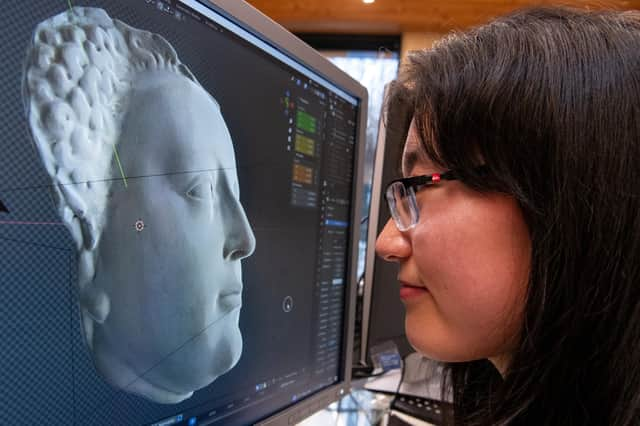Trainee creates digital death mask of Mary, Queen of Scots


A digital 3D model of Mary, Queen of Scots' death mask has been created to mark the 437th anniversary of the monarch's execution.
Mary was beheaded in Fotheringhay Castle in Northamptonshire on 8 February 1587, for conspiring against her cousin Queen Elizabeth I.
Advertisement
Hide AdAdvertisement
Hide AdThe digital death mask was created by Historic Environment Scotland (HES) from a plaster cast in its collection, taken from Mary's tomb effigy in Westminster Abbey.
It was created through photogrammetry, involving hundreds of overlapping high-resolution photographs being taken around the object and then analysed by software to work out their relative position.
HES said the digital documentation of historic sites and objects was "fundamentally changing the way we interact with history".
Yueqian Wang, a digital innovation trainee, who created the model as part of her training at HES, said: "Creating this model was hugely interesting but also challenging because I had to find ways to work round the metallic reflections and shadows captured in the photography, and make sure I was happy at each stage with what the software generated.
"I’ve always been interested in sharing stories from history with a wider audience as well as the practical side of heritage conservation.
"Digital Innovation is a perfect approach to work in both areas – I can share stories of the heritage object with more people by creating digital models, as well as supporting conservation experts by collecting detailed 3D data sets."
Mary Stuart was born at Linlithgow Palace in 1542, the only legitimate child of King James V.
She became Queen of Scots at only six days old following the death of her father, but spent most of her childhood in France while Scotland was ruled by regents.
Advertisement
Hide AdAdvertisement
Hide AdMary returned to Scotland in 1561 not long after the death of her first husband, Francis II, and married Henry Stuart, Lord Darnley, who was murdered in 1567.
She later married the main suspect, James Hepburn, Earl of Bothwell, but was imprisoned and forced to give up her crown in favour of her one-year-old son, James VI.
She fled to England to find the protection of her cousin, Queen Elizabeth I, but was confined in various castles for 19 years before being beheaded for allegedly conspiring against Elizabeth.
Death masks are a mould taken of an individual’s face after death and have been made by different cultures across the world for thousands of years.
Usually, masks would be created by taking a cast or impression of the deceased’s face which could then be used as a mould to create the final mask, often in wax or plaster.
It is thought that up to four death masks were cast from Mary's face shortly after her execution. The mask in the HES collection, however, is a plaster cast taken from her tomb effigy in Westminster Abbey, where she was buried in 1612 on the orders of her only son, King James VI and I.
Comments
Want to join the conversation? Please or to comment on this article.